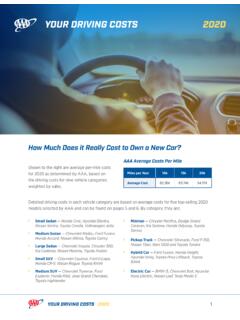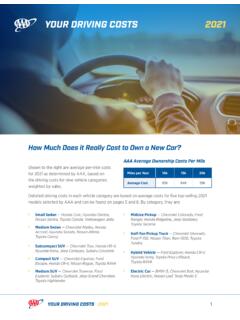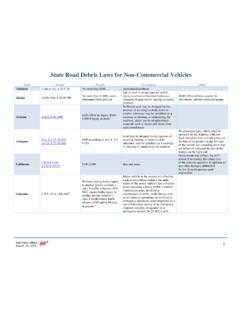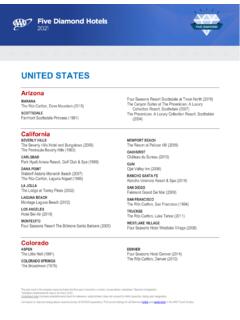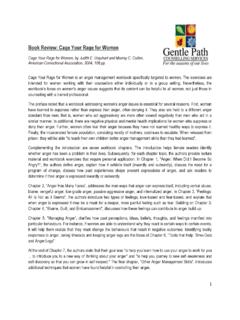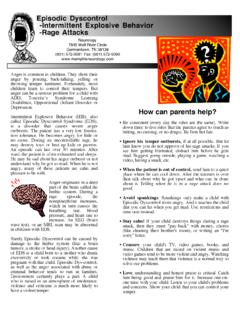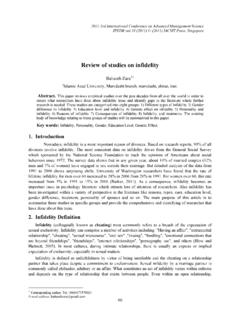Transcription of Road Rage: How to Avoid Aggressive Driving - AAA …
1 Road Rage: How to Avoid Aggressive Driving AAA Foundation for Traffic Safety By using the tips in this brochure, you can Avoid becoming a victim. In the process you may find that Driving has become a completely new and more enjoyable experience. Aggressive Driving is a major concern of the American public and a real threat to the safety of all road users. In a survey conducted by the AAA. Foundation, nearly 9 in 10 respondents said they believed Aggressive drivers were a somewhat . or very serious threat to their personal safety. This same survey found that a substantial number of drivers admitted to engaging in potentially Aggressive behaviors, such as traveling more than 15 mph above the speed limit, or running a red light.
2 Any unsafe Driving behavior, performed deliberately and with ill intention or disregard for safety, can constitute Aggressive Driving . In fact, a Foundation study found that potentially Aggressive actions . such as tailgating, erratic lane changing, or illegal passing are a factor in up to 56% of fatal crashes. In extreme cases, this may escalate to road rage, which is a violent criminal act involving an intention to cause physical harm. In a 2016 AAA Foundation study, many drivers admitted having let their anger and frustration get the best of them at least once in the past year, engaging in behaviors such as yelling, honking, gesturing at, or purposefully tailgating another driver.
3 However, you never know how another driver might respond; the same study found that nearly 8 million drivers had gotten out of their car to confront another driver or even bumped or rammed another car on purpose. AAA Foundation for Traffic Safety How can you Avoid being the victim of an Aggressive driver? Here are three basic guiding principles that can help: 1. 1. Don't offend When surveys ask drivers what angers them most, the results are remarkably consistent. A few specific behaviors seem unusually likely to enrage other drivers. You can protect yourself by avoiding them: Cutting off. When you merge, make sure you have plenty of room. Use your turn signal to show your intentions before making a move.
4 If you make a mistake and accidentally cut someone off, try to apologize to the other driver with an appropriate gesture. If someone cuts you off, slow down and give them room to merge into your lane. Driving slowly in the left lane. If you are in the left lane and someone wants to pass, move over and let them by. You may be in the right . because you are traveling at the speed limit --- but you may also be putting yourself in danger by making drivers behind you angry. In many states and provinces the law requires you to travel in the right lane and use the far left lane only for passing. Besides, it's simple courtesy to move over and let other drivers by.
5 Tailgating. Drivers get angry when they are followed too closely. Allow at least a two-second space between your car and the car ahead. [When you see the car pass a fixed point, you should be able to count at least one-thousand, two-thousand before you pass that point.]. If you think another car is Driving too slowly and you are unable to pass, pull back and allow more space, not less. That way if the car does something unexpected you will have time to get out of the way. You should be able to see the headlights of the car behind you in your rear-view mirror. If you feel you are being followed too closely, signal and pull over to allow the other driver to go by.
6 Gestures. Almost nothing makes another driver angrier than an obscene gesture. Keep your hands on the wheel. Avoid making any gestures that might anger another driver, even harmless expressions of irritation like shaking your head. Be a cautious and courteous driver. Signal every time you merge or change lanes, and whenever you turn. Use your horn rarely, if ever. If you and another driver see a parking space at the same time, let that person have it. And if another driver seems eager to get in front of you, say Be my guest. When you respond this way, after a while be my guest becomes your automatic response and you won't be as offended by other drivers' rudeness.
7 2. Don't engage One angry driver can't start a fight unless another driver is willing to join in. You can protect yourself against Aggressive drivers by refusing to become angry at them. Orator Robert Ingersoll said, Anger blows out the lamp of the mind. When angry, a person can do things they may later regret. If you're tempted to retaliate against another driver, think: Would I want to fly in an airplane whose pilot was acting like this? Think about what kind of a crash your angry actions could cause. Then cool down and continue your trip. Steer clear. Give angry drivers lots of room. A driver you may have offended can snap and become truly dangerous.
8 If the other driver tries to pick a fight, put as much distance as possible between your vehicle and the other car, and then get away as quickly as possible. Do not under any circumstances pull off to the side of the road and try to settle things man to man.. Avoid eye contact. If another driver is acting angry with you, don't make eye contact. Looking or staring at another driver can turn an impersonal encounter between two vehicles into a personal duel. And once things get personal, the situation can get out of hand fast. Get help. If you believe the other driver is following you or is trying to start a fight, get help. If you have a cell phone, use it to call the police.
9 Otherwise, drive to a place where there are people around, such as a police station, convenience store, shopping center, or even a hospital. Use your horn to get someone's attention. This will usually discourage an aggressor. Do not get out of your car. Do not go home. 3. Adjust your attitude The most important actions you can take to Avoid Aggressive Driving take place inside your head. By changing your approach to Driving , you can make every trip more pleasant. Try these ideas for a pleasant change: Forget winning. For too many motorists, Driving becomes a contest. Do you allow the shortest possible time for a trip and then race the clock? If something happens to slow you down do you get angry?
10 The solution: Allow more time for your trip. You'll be amazed at how much more relaxed you feel when you have a few extra minutes. So instead of trying to make good time, try to make time good. Listen to soothing music or a book on tape. Practice relaxation techniques, such as deep breathing. You'll arrive much calmer, fresher, and in a less stressed-out frame of mind. Put yourself in the other driver's shoes. Instead of judging the other driver, try to imagine why he or she is Driving that way. Someone speeding and constantly changing lanes may be a volunteer fireman, or a physician rushing to a hospital. Someone who jerks from one lane to another may have a bee in the car or a crying baby.
